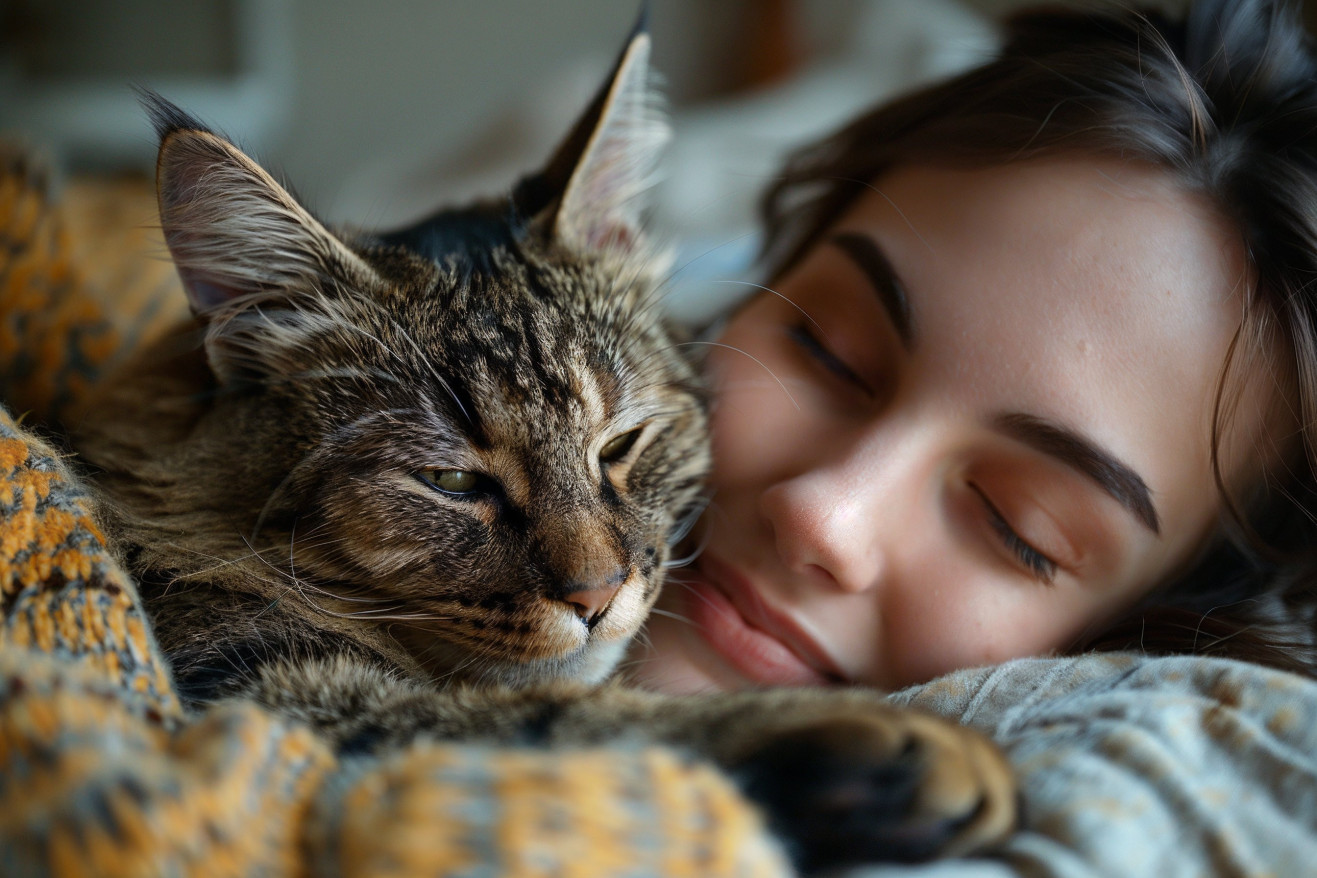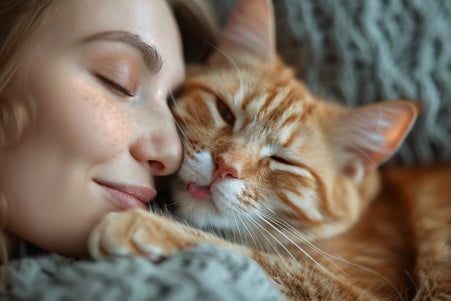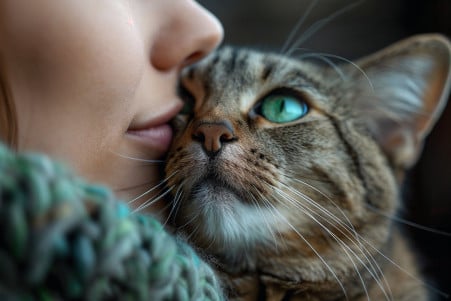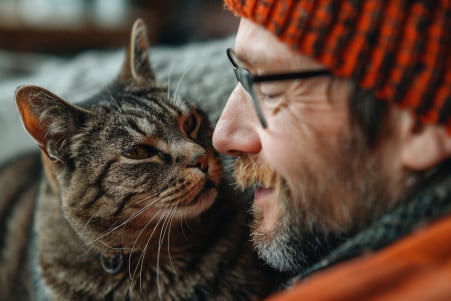Why Does My Cat Put His Paw on My Mouth? Decoding Feline Gestures
8 March 2024 • Updated 7 March 2024

If your cat has ever reached out and gently placed a paw on your mouth, you know that it can be a bit of a head-scratcher.
However, there are several reasons why your cat may be doing this. Some of the most common include that your cat is showing you affection, asking for attention, or trying to communicate with you.
In addition, your cat may be using this behavior to mark you with its scent, show that it feels safe with you, or let you know that it wants to play or eat. Regardless of the reason, this behavior is a sign of the trust and bond that you and your cat share.
To help you better understand why your cat is reaching out to touch your face, we’ll take a deep dive into the world of animal behavior science, specifically feline ethology. We’ll also look at scholarly articles and interviews with cat behaviorists to help you gain a better understanding of the complexities of cat communication.
By looking at the sensory, cognitive, and social factors that influence feline behavior, we hope to give you a well-rounded view of your furry friend’s loving and sometimes confusing behaviors.
Why does my cat put his paw on my mouth?
Decoding the Cat’s Language: How Cats Communicate
Cats are known for their excellent communication skills, and they have a complex language that includes tactile, visual, vocal, and olfactory communication. According to International Cat Care, tactile communication is particularly important to cats and is used for social interaction and marking territory. When a cat puts a paw on you, it’s using a form of tactile communication that is important in its language and relationships.
Tactile communication isn’t just about showing affection; it has many uses for cats. For example, head bunting and tail wrapping are ways to show affection and exchange scents, but they are also ways for cats to show their social status. As PetMD notes, cats use physical touch, including pawing, to communicate with other cats and with humans, and it’s a sign of trust, security, and sometimes a way to show that they own something.
Visual communication, such as tail positions and ear positions, can also help cats communicate, and vocal communication can be used to express a wide range of emotions. Through all of these forms of communication, cats let us know how they’re feeling and what they want, and they help us understand their world.
Sensory Factors That May Contribute to Pawing
Cats’ highly sensitive sensory systems play a major role in how they experience the world around them. For example, PAWS Chicago reports that cats have more than 200 million odor sensors, meaning that cats’ sense of smell is 14 times more sensitive than that of humans.
This sensitivity allows cats to pick up on a wide range of scents, which may help explain why they are drawn to the smell of a person’s breath and then use their paw to cover their mouth.
Touch is also important to cats, and the nerve endings in their fur can be stimulated in ways that lead to relaxation. According to Feliway, cats’ whiskers, or vibrissae, are sensitive and help cats gather information about their environment and move through it.
They are able to pick up on small changes in their environment, such as a breeze or the presence of an object, and this information can help cats better understand their surroundings. When a cat uses its paw to touch a person’s face, it’s using its sense of touch and its whiskers to gather information and communicate.
In addition, PAWS Chicago reports that cats have excellent hearing and can hear higher frequencies than dogs, which helps them coordinate their tactile behaviors with the sounds around them.
While the relationship between these senses and behaviors like pawing is not yet fully understood, this perspective underscores the importance of cats’ senses and how they may be involved in the emotional and stress-related information cats may be trying to convey when they paw at their owners.
Breaking Down the Emotional Impact: Stress and Comfort in Cats
If your cat is putting their paw on your face, it may not just be a cute quirk; it may be an emotional cry for help. A study in the Journal of Veterinary Behavior found that stress in cats can lead to a variety of different behavioral changes.
These changes can include a loss of appetite, an increase in aggression, or compulsive behaviors like over-grooming or pawing at their human. This pawing may be a way for cats to seek comfort during times of stress.
Cats are known to express their stress through body language and physical touch. A study in PMC found that stressors like changes in the environment and disruptions in a cat’s routine can lead to sickness behaviors like not eating or using the litter box. When this happens, cats may look to their humans for comfort and security through physical touch, often in the form of a paw on their person.
By recognizing these signs of stress and responding with comforting touch, humans can build a stronger bond with their cats. Understanding these emotional cues and meeting our cats’ psychological needs is important for their happiness and our relationship with them. This is true for all behaviors, including those that are picked up from their interactions with humans.
Learned Behaviors: Training and Conditioning in Cats
Cats are known for their love of routine, and many of their behaviors can be chalked up to learning and conditioning.
For example, when your cat puts its paw on your mouth, it could be a learned response that has been reinforced by the way you react.
A pilot study on positive reinforcement in cats, which was published in ScienceDirect, concluded that operant conditioning using rewards is an effective way to train cats to perform specific behaviors.
In addition, research on cat preferences has shown that cats value social interaction, which means that an owner’s attention could be a powerful reinforcer for certain behaviors. Owners may inadvertently reinforce their cats’ pawing behavior by responding with petting, talking, or treats. This is a classic example of the principles of operant conditioning, in which the consequences of a behavior determine whether it will be repeated in the future.
A better understanding of the nuances of training and reinforcement can help us improve our relationships with cats and encourage behaviors that will help strengthen the human-cat bond. By recognizing the impact of our responses on our cats’ behaviors, we can create a more harmonious home life that meets the needs of both cats and humans.
Understanding the Complex Language of Cat Body Language
The subtle language of cats is full of silent messages, from the way they move their tails and ears to the way they touch you. Cat body language is a complex combination of visual signals.
For example, a study in Scientific Reports found that cats use the slow blink to show trust and affection to humans. Meanwhile, the tail-up position, as outlined in the journal Animals, is a visual indicator of a cat’s positive emotional state when it comes to interacting with humans, often leading to other signs of affection like head rubbing.
When a cat puts a paw on a human’s mouth, it’s adding another layer to its already complex system of visual and tactile communication. It’s a subtle sign that, in the context of cat body language, could be a sign of trust, affection, or a request for attention. A study from PubMed explains that this is because these signs can be motivated by a number of emotions at the same time.
When trying to understand what a cat is saying when it places a soft paw on your mouth, it’s important to look at the context of the behavior. Is it happening during a time of relaxation, when the cat is asking for something, or when the cat is seeking comfort?
By looking at the cat’s other body language and understanding the many emotions cats can feel, we can better understand and bond with these complex animals.
Decoding the Feline Touch: What It Means When a Cat Puts a Paw on Your Mouth
As we’ve seen, the more we learn about our cats and their behaviors, the more we realize that when a cat puts a paw on your mouth, it can mean many things. It can be a sign of love, a call for attention, a learned behavior that we’ve inadvertently reinforced, or an emotional signal that the cat is feeling stressed or safe.
Cats have developed their tactile language as part of a larger set of sensory-based communication tools that are a product of both evolution and their individual lives.
Understanding these behaviors can help us form stronger relationships with our cats. When we learn to interpret the subtleties of cat body language, we can better understand their wants and feelings, leading to a relationship that’s based on understanding and trust.
By taking into account the sensory, emotional, and learned components of cat behaviors, we can get a more complete picture of what our cats are trying to tell us. In the end, let’s take this knowledge with us and continue to learn about the silent but meaningful ways our cats communicate.
After all, a cat’s paw on our mouth—like all of their behaviors—is just one element of the intricate mosaic of our relationships with them, which is woven from the strands of trust, love, and the unspoken communication of cohabitation.


